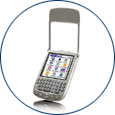 Index
Index
- Description
- Points to ponder
- Mainstream PDAs and their associated operating systems
- Other portable notetaking devices ( keyboard based )
- Accessibility add-ons for mainstream PDAs
- PDAs designed specifically for users with disabilities
- Resources
This list is for reference purposes only and does not reflect endorsement by the IDRC.
Description
Display-based Personal Data Assistants (or PDAs) are handheld computers like the Palm or iPAQ. PDAs were originally used mainly for organizational purposes such as acting as electronic day planners, but new technology has led to their increased usage in many different tasks, formerly only possible with a home computer. The organizational capabilities of a PDA alone may be helpful for users with learning or cognitive disabilities, but there is also a whole host of programs that make the PDA a useful device for users with other disabilities. Mainstream PDAs are generally inaccessible for people with visual disabilities, but they may be used by people with other disabilities; there is an ever-growing range of software and add-on hardware that can help make the devices more universally accessible. There are also portable devices designed specifically for individuals with disabilities or impairments, and those running Palm OS or Windows CE are listed in this section. For other mobile devices designed for users with disabilities, our technical glossary has two additional sections: Non-display-based Personal Data Assistants and Voice Output Communication Aids.
Points to Ponder - Questions to consider when shopping for a display-based personal data assistant
- Is it compatible with your home computer's platform?
- Does it have expandable memory?
- Does it have multi-language support?
- Does it have an adjustable display?
- Is there a range of accessibility add-ons available for the particular model you are considering?
Mainstream PDAs and their associated operating systems
- The Palm Pilot uses the PalmOS as its operating system, and is compatible with both Windows and Macintosh computers.
- Casio's portable PCs use a range of operating systems, but none of them are Mac compatible.
- HP offers their HP iPAQ Pocket PC's series in a few different models. There is also an HP iPAQ Pocket PC Buying Guide on the HP website.
Other portable notetaking devices ( keyboard based )
- AlphaSmart is a provider of technology solutions for education and productivity, focused on reducing the cost and complexity of computing. AlphaSmart manufactures two products:
- QuickPAD by QuickPAD Technology Corporation. QuickPAD IR and QuickPAD PRO are designed to make mobile computing easy when it comes to data entry tasks. Simple technology coupled with notebook applications let you efficiently word and data process, manage and organize your contacts, schedule appointments and more.
- Perfect Solutions has produced LaserPC6, a simple and inexpensive notetaking device. It has a large switchable display and 8 built-in programs including a typing tutor and word prediction, plus a Text-to-Speech option.
Accessibility add-ons for mainstream PDAs:
- TealPoint has designed a number of accessibility programs for palm devices. These are all compatible with the Palm OS, but please note that you should test these products on a palm device before you purchase either. Also, TealMagnify has limited capabilities for magnification and may not magnify in the manner you are used to on a PC.
- TealScript - fully configurable text recognition system, replacing the standard Graffiti system of text input
- TealPaint - allows you to draw and manipulate images on your palm device
- TealMagnify - allows you to magnify parts of your palm device screen -you have to activate it by touching a small magnifying glass on the screen, so it may not be the solution for people with visual disabilities.
- TealGlance - automatically shows you the time, current appointments and other commonly used information, on start up
- TealAgent - formats local, network, and web-resident data for viewing with Palm handhelds These products are shareware and are available for a nominal charge.
- The Nuance hardware compatibility feature allows you to find all the Display Based PDA's and Mobility Devices that are compatible with any Nuance Voice Recognition Software.
- Matias has produced a half keyboard for use with a Palm OS PDA, PC or Mac. This device may be useful for people with mobility in only one hand.
- The AlphaPad, released by Input Technologies, is a Palm OS-compatible program that utilizes both finger touch communication (using an on-screen keyboard of only 12 keys) and word prediction software. This could be useful for low-mobility users, although the touch-screen requires fine motor skills.
- WordLogic has developed "advanced text input software" for handheld PDAs which is compatible with Windows CE. The WordLogic keyboard has word prediction capabilities, adapts to new words, and customizes itself according to most commonly used words. Its touch-screen means that it is accessible only by users with fine motor skills, and the colour scheme of the WordChunking feature may be similarly inaccessible for users with vision impairment.
- Textware Solutions has produced the FitalyStamp, an overlay that covers the bottom of the Handspring Visor's screen. It replaces Graffiti as a text input system; it also uses sliding (across keys) as a method of capitalizing lowercase letters, which is a much faster and accessible method than pressing Shift at the same time. It may take a while to become familiar with this system, but it generally speeds rate of text input.
- Thumbscript is a text entry system that uses a 9-button grid and is compatible with Palm-based devices, telephones, television controllers and eight-sided joysticks. Simple key combinations correspond to all characters and functions on a standard keyboard. Using Thumbscript codes, e-mail can be sent from any touch-tone phone (with paid Thumbmail service), and a 9-button Feather-Touch Input Device can be purchased separately for your home computer. For purchasing information, see the Yahoo! Thumbscript store. To try the Thumbscript code for yourself to test its usability, try this demo (Java required).
PDAs designed specifically for users with disabilities
- DynaVox makes a line of portable communication devices. The latest models, the iChat3 and Palmtop3 provide a small, lightweight portable device with powerful communication abilities. The feature-rich Impact® communication software and sleek styling combine to appeal to augmented communicators of all ages.
- Dynavox also offers the Dynamo, a touch-screen portable communication device, which has a built in universal remote control, integrated microphone and speech output capability.
Resources
- Are personal data assistants (PDAs) accessible?, from the National Center on Accessible Information Technology in Education in Washington
- The PDA Buyer's Guide: A good resource containing reviews of mainstream PDAs.
- PDAGeek: Message boards, reviews, tips and tricks and more concerning PDAs.




